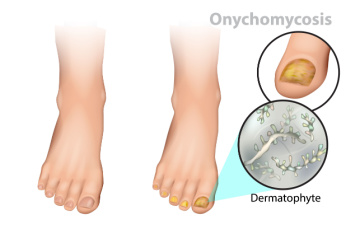
Toenail fungus is caused by the overgrowth of fungi such as dermatophytes and yeast in the toenail. These fungi can be airborne or naturally present on the skin, finding their way to the foot or toenail. They thrive in warm, humid environments, so damp or sweaty feet create ideal conditions for fungal proliferation. Any cracks or tears in the skin or nail can serve as entry points, allowing the fungi to penetrate deeper tissues. Once inside, they feed on the nail tissue, causing the nail to thicken, discolor, and detach from the nail bed as fungal debris accumulates. Common symptoms of toenail fungus include thickened, yellow, brown, or white nails that may develop cracks over time. While the infection often starts without pain, it can become progressively severe. Risk factors for toenail fungus include old age, previous nail trauma, and wearing tight footwear. Engaging in activities like running or swimming, and having conditions such as diabetes, blood circulation problems, are possible causes. If left untreated, toenail fungus can spread to surrounding skin, other nails, and even other parts of the body If you have developed a toenail infection, it is suggested that you schedule an appointment with a chiropodist for an exam, diagnosis, and treatment options.
Toenail fungus can be uncomfortable and unsightly. If you have diabetes or a compromised immune system, it may also be dangerous. To learn more about treatment options, please consult with Cynthia Chan, B.Sc., D.Ch from Healthy Advantage Foot & Orthotic Clinic. Our practitioner will assess your condition and provide you with quality foot and ankle treatment.
What Does Toenail Fungus Look Like?
A fungal infection of the toenail may cause the affected nail to become thickened, brittle, crumbly, and yellowish or brown in color. Sometimes the toenail may separate from the nail bed, become deformed, emit a foul odor, or cause pain or discomfort.
What Causes Toenail Fungus?
Toenail fungus is caused by a fungus that infects the nail bed. The fungus lives and thrives in warm and moist environments and is also contagious. Athlete’s foot, which is a fungal infection of the skin, may spread to the nails and cause toenail fungus.
What Treatments Are Available?
Potential treatments for toenail fungus may include oral antifungal medications, topical antifungal medications, such as medicated nail polishes that are applied directly to the affected nail, and laser therapy. Sometimes, a combination of treatments is prescribed.
If you have any questions, please feel free to contact our office located in . We offer the newest diagnostic and treatment technologies for all your foot care needs.